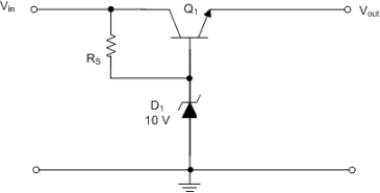A) Regulator A
B) Regulator B
D) undefined
Correct Answer

verified
Correct Answer
verified
Multiple Choice
Which type of voltage regulator would use a crowbar?
A) Series-pass regulator
B) Shunt regulator
C) Switching regulator
D) None of the above.
F) A) and B)
Correct Answer

verified
Correct Answer
verified
Multiple Choice
 -Q1 in Figure is called a transistor.
-Q1 in Figure is called a transistor.
A) pass
B) line
C) series
D) regulator
F) A) and C)
Correct Answer

verified
Correct Answer
verified
Multiple Choice
The ability of an IC voltage regulator to attenuate any input ripple voltage is called its rating.
A) ripple attenuation
B) ripple reduction
C) ripple rejection
D) ripple elimination
F) A) and B)
Correct Answer

verified
Correct Answer
verified
Multiple Choice
Using a signal to vary the pulse width of a rectangular wave without affecting its cycle time is called .
A) variable off-time modulation
B) pulse width modulation
C) power switch conduction
D) None of the above.
F) None of the above
Correct Answer

verified
Correct Answer
verified
Multiple Choice
A switching power supply has the following values: Vin = 18 Vdc, Ton = 4 ms, and Toff = 8 ms. What is the value of Vout for the circuit?
A) 27 Vdc
B) 9 Vdc
C) 6 Vdc
D) 12 Vdc
F) None of the above
Correct Answer

verified
Correct Answer
verified
Multiple Choice
is a rating that indicates the change in regulation output voltage that occurs per unit change in input voltage.
A) Regulation
B) Line regulation
C) Load regulation
D) Series regulation
F) A) and C)
Correct Answer

verified
Correct Answer
verified
Multiple Choice
The the load regulation rating of a voltage regulator, the higher the quality of the circuit.
A) lower
B) higher
D) undefined
Correct Answer

verified
A
Correct Answer
verified
Multiple Choice
The ideal line regulation rating is
A) extremely high.
B) in the range of 1 μV/V to 20 μV/V.
C) in the range of 0.1 μV/V to 1 μV/V.
D) zero.
F) A) and C)
Correct Answer

verified
Correct Answer
verified
Multiple Choice
What type of IC voltage regulator requires both positive and negative input voltages?
A) The fixed-negative regulator
B) The adjustable regulator
C) The variable polarity regulator
D) The dual-tracking regulator
F) A) and C)
Correct Answer

verified
D
Correct Answer
verified
Multiple Choice
 -Which of the following best describes the circuit in Figure?
-Which of the following best describes the circuit in Figure?
A) Series-pass regulator with voltage feedback
B) Shunt regulator with voltage feedback
C) Series-pass regulator without voltage feedback
D) Shunt regulator without voltage feedback
F) B) and C)
Correct Answer

verified
Correct Answer
verified
True/False
Both linear and switching regulators can function as step-up regulators.
B) False
Correct Answer

verified
Correct Answer
verified
Multiple Choice
A dual-polarity power supply would use a regulator.
A) Fixed-positive regulator
B) Fixed-negative regulator
C) Dual-tracking regulator
D) Both A and B
F) C) and D)
Correct Answer

verified
Correct Answer
verified
Multiple Choice
A voltage regulator has the following ratings: Vin = 10 Vdc to 15 Vdc, IL = 20 mA maximum) , and regulation = 0.01%. Which of the following statements is true?
A) The load current demand on the regulator cannot exceed 20 mA.
B) The rated output voltage must be some value that is less than 10 Vdc.
C) The rated output voltage falls somewhere between 10 Vdc and 15 Vdc.
D) As long as the input voltage remains within its rated range, Vout will equal 0.01% of Vin.
F) B) and C)
Correct Answer

verified
Correct Answer
verified
Multiple Choice
 -What is the purpose of RS?
-What is the purpose of RS?
A) It provides shorted load protection
B) It provides biasing current for Q1
C) It provides current for the zener diode
D) It reduces the power dissipated by the transistor
F) A) and C)
Correct Answer

verified
Correct Answer
verified
Multiple Choice
Which of the following is not a type of IC voltage regulator?
A) Fixed negative
B) Adjustable
C) Variable polarity
D) Dual-tracking
F) A) and C)
Correct Answer

verified
C
Correct Answer
verified
Multiple Choice
A voltage regulator is rated for an output range of IL = 0 to 40 mA. Under no-load conditions, the output voltage from the circuit is 4 Vdc. Under full-load conditions, the output voltage from the circuit is 3.984 Vdc. What is the load regulation rating of the circuit?
A) 400 μV/mA
B) 2.5 mV/mA
C) 0.4 Ω
D) Both 400 μV/mA and 0.4 Ω are correct.
F) A) and C)
Correct Answer

verified
Correct Answer
verified
Multiple Choice
The ideal voltage regulator maintains a constant dc output voltage despite anticipated changes in
A) its input voltage.
B) its output voltage demand.
C) its load current demand.
D) its load current demand and/or its input voltage.
F) All of the above
Correct Answer

verified
Correct Answer
verified
Multiple Choice
 -The regulated output voltage from the circuit in Figure is
-The regulated output voltage from the circuit in Figure is
A) 10.7 V.
B) 10 V.
C) 9.3 V.
D) equal to the difference between Vin and the zener voltage rating.
F) C) and D)
Correct Answer

verified
Correct Answer
verified
Multiple Choice
A voltage regulator has an output that changes by 2 μV when its input changes by 10 V. The line regulation rating of the device is
A) 0.02 μV/V.
B) 50 μV/V.
C) 20 μV/V.
D) 9.998 V/V.
F) C) and D)
Correct Answer

verified
Correct Answer
verified
Showing 1 - 20 of 25
Related Exams